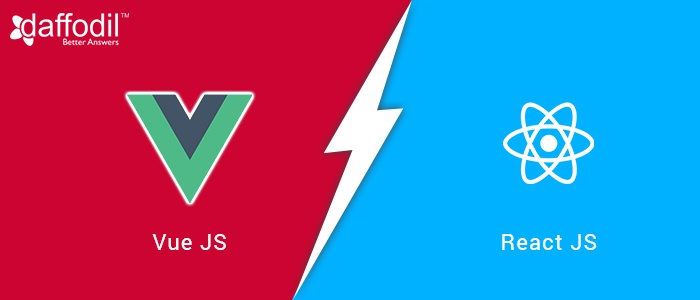
Almost all software product engineering companies struggle in the quest of choosing the best technology stack for developing their product. After all, it is the technology that can turn greatest of the ideas into a mediocre product. Hence, it is of utmost importance to ponder upon all the available technology options and choose the best.
The problem becomes more pertinent while choosing the most apt technology between ReactJS and VueJS. Though, both technologies seem alike at the first glance, however, differences emerge as we dive deep into the core.
In this article, we will try analyze pros and cons of both the technologies, and figure out what to choose, why choose and how to choose.
React.JS, developed by Facebook, is a javascript library that is designed for front-end development. React uses composable components and virtual Dom to make Web UIs. Due to a large online community, ReactJS docs and tutorials can be easily gathered. It serves as V in MVC architecture by allowing users to interact with the data of components.
On the other side, Vue.JS is developed by Evan You, who initially worked for Google on AngularJS. Vue.JS also uses composable components and virtual DOM to make Web Uis however, Vue’s virtual Dom is more lighter than other JS languages’ virtual DOM.It serves as V and lightly C in MVC architecture by allowing users to interact with the data of components.
Similarities in Both Libraries:
1. Both libraries uses virtual DOM. A virtual DOM is tree of javascript objects that has the reference to HTML elements.2. Both Libraries provides composable view components i.e. both uses component structure to make web UIs.
3. Both libraries have the focus on core libraries of JS i.e. routing and global state management.
Comparison between React JS and Vue JS :
1. Throughput :
Since React JS and VueJS both makes the tree of javascript objects for DOM manipulation (ie. virtual DOM). VueJS has the benefit of having a lightweight Virtual DOM than ReactJS, which can be easily visualized from following eg. -
A simple ReactJS Code:
<html>
<head>
<title>Simple React App</title>
<script src=”https://fb.me/react-15.0.0.JS”></script>
<script src=”https://fb.me/react-dom-15.0.0.JS”></script>
<script src=”https://cdnJS.cloudlare.com/ajax/libs/babel-core/5.8.34/browser.min.JS” ></script>
</head>
<body>
<div id=”iteration”></div>
<script type=”text/babel”>
var Iterator=React.createClass({
getInitialState(){
return {
array:[10,20,30,40]
}
},
render(){
this.state.array.map(function(value){
return (<p>{value}</p>)
});
}
});
ReactDom.render(</Iterator>,document.getElementById('iteration'))
</script>
</body>
</html>
A simple VueJS Code
<html>
<head>
<title>Simple Vue App</title>
<script src=”https://vueJS.org/JS/vue.min.JS”></script>
</head>
<body>
<div id=”iteration”>
<span v-for=”value in array”></span>
</div>
<script>
var Iterator=new Vue({
el: '#iteration',
data:{
Array:[10,20,30,40,50]
}
});
</script>
</body>
</html>
2. Reactivity : In VueJS, each variable is reactive. That means each variable has observables and watchers attached. This feature is very useful in two way binding while in ReactJS, you don't have these type of inbuilt features. You have to explicitly add the two way data binding either by props or by state.
Two way Data Binding in VueJS
<span>ReactJS Vs VueJS? Which one to choose for your web app development?</span><br/>
<input v-model="name">
</div>
<script type="text/javascript">
var name = 'Steve Jobs';
new Vue({ el: '#portfolio', data: { name } });
</script>
Two way Data Binding in ReactJS
var NoLink = createReactClass({
getInitialState: function() {
return {name: 'Steve Jobs'};
},
handleChange: function(event) {
this.setState({name: event.target.value});
},
render: function() {
var message = this.state.message;
return <input type="text" value={name} onChange={this.handleChange} />;
}
});
In the above example, to achieve two way data binding we are handling the onChange event explicitly. As user changes the value of input field handleChange method will be called which updates the state of current component as a result new value will be assigned to name variable.
3. Optimization Techniques: In ReactJS, whenever the state changes (either of root component or subcomponent) whole component is re-rendered. This causes a sence of frustration at the developer’s end . Even we can handle the re-rendering of component by using PureComponent or ShouldComponenetUpdate. However, in certain cases you may not be able to rely on such optimization techniques because PureComponent or shouldComponentUpdate assumes the entire sub tree’s render output is determined by the props of the current component. If that is not the case, then such optimizations may lead to inconsistent DOM state.
However, in VueJS the system knows precisely which components actually need to re-render when the state changes. Each component can be considered to have shouldComponentUpdate automatically implemented for you, without the nested component caveats.
4. Universal Facility : This is the great feature of ReactJS which makes it so popular. ReactJS can be used on client side as well as on server side this facilitates the sharing of code or model on both side and also remove duplicacy of code since some common libraries of ReactJS (react router, babel etc) are used on both sides. However, in VueJS we don't have any such type of facility.
So which technology to choose for development. Well, It is hardly possible to say at this moment as both technologies have their own pros and cons. React JS has large community and vast scope, however if we analyze the ratings and reviews of VueJS on Github, it clearly state that the future belongs to VueJS. Its clearly a state of dilemma to choose the best among them. Till we find any concrete reason to strike out the best, we'd suggest you to choose the one which fulfills your project requirement and have features that are required in your application.



